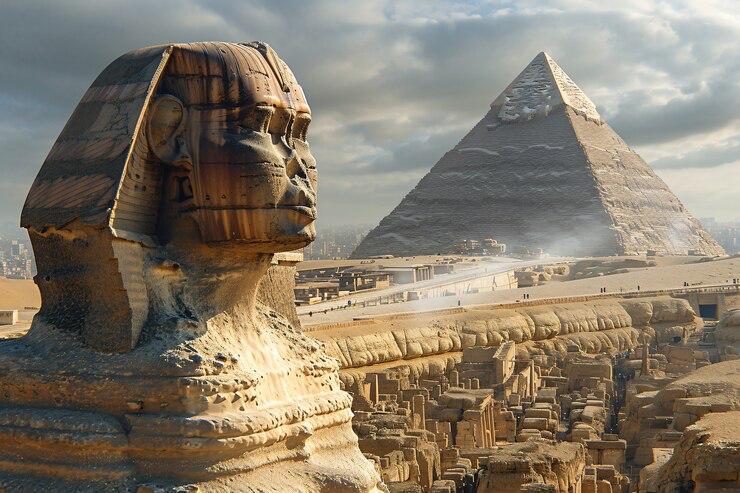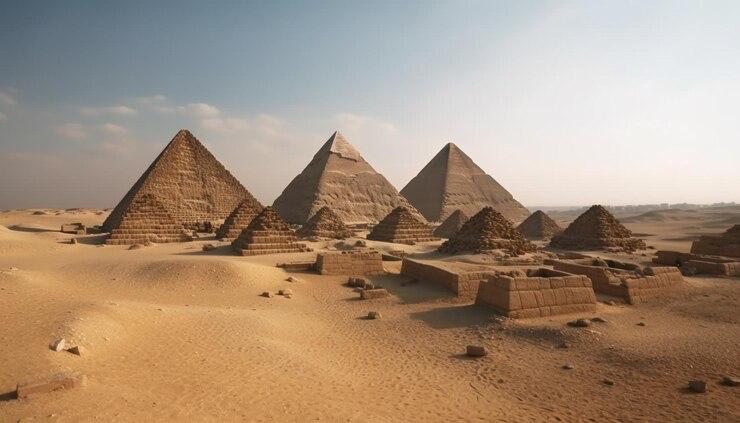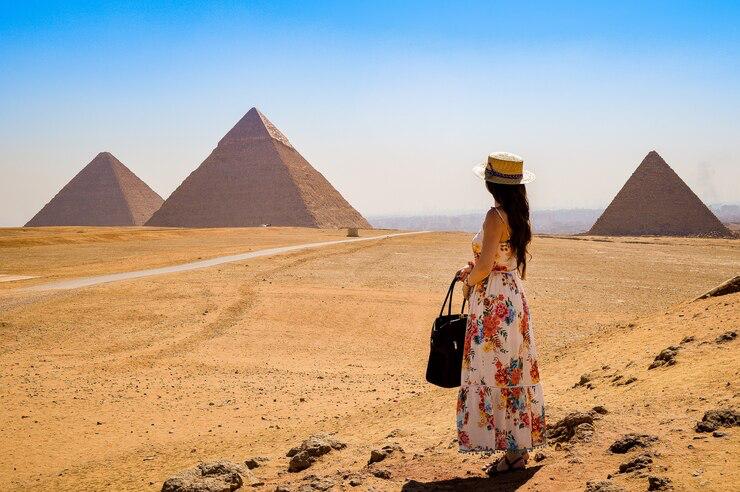Table of Contents
Giza Pyramids: A Journey Through Time
One of humanity’s greatest accomplishments is the Giza Pyramids, enormous stone constructions that have stood the test of time for more than 4,000 years. It is nearly hard to avoid feeling amazement when we look at them now, rising from the desert dunes just outside of contemporary Cairo. The final remaining wonder of the original Seven Wonders of the World, these structures offer a glimpse into the spirit of ancient Egypt and are much more than just old tombs.

Best Time to Visit the Giza Pyramids
The best time to visit the Giza Pyramids is during Egypt’s cooler months, from October to April. During this period, temperatures are more comfortable, ranging from 20°C to 26°C (68°F to 79°F), making it much easier to explore the site without the intense desert heat.
- Peak Season: December to February (milder weather, but also more crowded)
- Shoulder Seasons: October–November and March–April (pleasant weather, fewer tourists)
Visiting Hours
- Summer (April to September):
7:00 AM – 6:00 PM - Winter (October to March):
8:00 AM – 4:00 PM
Important tip:
If you want to enjoy the Giza Pyramids with fewer crowds and cooler air, try to arrive early in the morning right when the site opens.
Extra Experience
- There’s also a Sound and Light Show at night that tells the story of the pyramids with dramatic lighting effects. It usually starts around 7:00 PM or 8:00 PM, depending on the season.
A Synopsis Giza Pyramids:-

The Great Pyramid of Khufu (Cheops), the Pyramid of Khafre (Chephren), and the Pyramid of Menkaure (Mykerinos) are the three principal pyramids on the Giza Plateau. The enigmatic Great Sphinx, lesser “queen’s pyramids,” temples, and enormous graves for the pharaohs’ servants and nobility are also close by.
These pyramids, which were constructed during Egypt’s Fourth Dynasty (c. 2600–2500 BCE), represent a civilization’s pursuit of immortality. The colossal tombs built by the pharaohs were intended to guarantee their eternal life among the gods.
However, how were they constructed? Why? What mysteries remain concealed among the stones? Let’s investigate further.
The Builders Giza Pyramids : Skilled Workers, Not Slaves:-

For ages, there was a widely held belief that the pyramids were constructed by armies of slaves who were killed by ruthless pharaohs. The picture presented by contemporary archaeology is far more human.
The remains of sizable worker settlements close to the pyramids have been found during excavations. These were well-housed, well-fed laborers, not slaves, and many of them were rather proud of their position. Engineers, haulers, stonecutters, and skilled artisans worked together on the project. In addition to working in rotating teams, they were honored with dignified burials close to the pyramids.
Imagine living in stone dorms, eating almost 4,000 pounds of beef a day, working in scheduled shifts, and after a long day, enjoying bread and beer. Like the building of a major church today, it was a revered national endeavor, even though it was not a life of luxury.
The Building Giza Pyramids: Engineering Wonders:-

For more than 3,800 years, the largest man-made edifice in the world was the Great Pyramid of Khufu, which stood at an initial height of 146.6 meters (481 feet). Its base is roughly 230 meters (756 feet) on each side. Constructed from around 2.3 million slabs of granite and limestone, each weighing 2.5 to 15 tons, its construction is still astounding.
Methods
Nobody knows exactly how they achieved it. However, the majority of specialists concur on a few methods:
Quarrying: Harder granite for the inner chambers came from Aswan, more than 800 kilometers (500 miles) distant, but the majority of the stones came from local quarries.
Transport: A simple yet ingenious innovation verified by testing, stones were dragged on sleds across the desert, probably across wet sand to reduce friction.
Ramp Systems: To move the stones up as the pyramid rose, enormous ramps made of mudbrick and limestone chips may have been constructed around it.With amazing accuracy, each stone was manually put. The Great Pyramid’s near-perfect alignment with the cardinal points—north, south, east, and west—is actually a difficult-to-replicate achievement of astronomical and mathematical talent.
Why were such huge constructions made like the Giza Pyramids?
Death, according to ancient Egyptian thought, was only the beginning. The Giza Pyramids, a form pointing to the heavens, represented the passage to the afterlife that pharaohs needed to protect.
There was more to the pyramid complex than merely a tomb. It was a huge place of worship. Each Giza Pyramids had a causeway that led to a valley temple close to the Nile, where the king’s body was prepared, as well as a mortuary temple for king-honoring rites.
The King’s Chamber, Queen’s Chamber, and enigmatic Grand Gallery within the Great Pyramid all allude to profound symbolic significance. A profound fixation with preserving the pharaoh’s immortality is suggested by the intricate tunnels, fake passageways, and enormous granite blocks erected to guard the king’s coffin.
The secrets inside the Giza pyramids:-
The pyramids continue to hold secrets even after decades of research.
Using cosmic-ray imaging, researchers found a sizable concealed gap above Khufu’s pyramid’s Grand Gallery in 2017. Why? Not sure. Others question if it’s a secret burial chamber or a place to store ceremonial items. Still others think it might be a relieving chamber to keep it from collapsing.
There are numerous such mysteries:
Without access to contemporary instruments, how were the ancient Egyptians able to attain such mathematical precision?
What does the inside design of the pyramid actually mean?
Did the pyramids' positions, angles, and proportions have symbolic meanings?The pyramids continue to exist not only in stone but also in mystery as each new answer we discover appears to raise more questions.
The Sphinx: Plateau’s Protector:-
It would be impossible to discuss Giza without bringing up the Great Sphinx. Directly carved from a natural limestone outcrop, this enormous statue features the head of a ruler (possibly Khafre) and the body of a lion.
The Sphinx is the largest monolithic statue in the ancient world, measuring 73 meters (240 feet) in length and 20 meters (66 feet) in height. It is marred by time, erosion, and human vandalism; its renowned missing nose was probably lost centuries ago.
The purpose of the Sphinx is still unknown. According to some ideas, it was a solar emblem, a protector of the necropolis, or perhaps a depiction of the king as the sun deity Ra.
It’s interesting to note that the Egyptians themselves initiated the initial restoration attempts. Inscriptions dating back more than 3,000 years have been discovered by archaeologists.
It’s interesting to note that the Egyptians themselves initiated the initial restoration attempts. Inscriptions dating back more than 3,000 years have been discovered by archaeologists that describe how ancient emperors commanded the Sphinx to be repaired!
Contemporary Conservation and Dangers:-
The Giza Pyramids now face issues that the original designers could not have predicted: climate change, erosion from tourists, and pollution from Cairo’s expansion.
To protect these wonders for future generations, the Egyptian government and international organizations are working tirelessly. The monuments are documented and preserved with the aid of meticulous excavation, 3D modeling, and advanced laser scanning.
Standing in front of these ancient giants while contemporary city activity hums just beyond the plateau makes visiting Giza today a confusing experience. However, the pyramids continue to captivate people in spite of the passage of time.
In conclusion, a timeless legacy:-
The Giza Pyramids are remarkable for many reasons than merely their grandeur, age, or enigmatic construction. They are potent because they embody humanity’s aspiration to transcend the here and now and create something enduring.
You may feel the spirit of individuals who lived 45 centuries ago as you stand at the base of the Great Pyramid and gaze up at those enormous blocks stacked higher than a contemporary skyscraper. Those who dreamed of eternity while gazing at the skies.
The pyramids serve as a reminder that some dreams, such as the desire to touch the sky, are genuinely ageless in a time of ephemeral fads and quick change.

